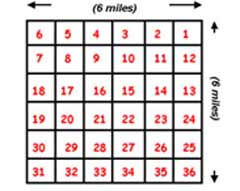

7.5 Minute refers to the fact the map covers an area 7 minutes and 30 seconds of longitude by 7 minutes and 30 seconds of latitude. Note: a minute is one 60th of a degree, and not a measure of time. The most commonly used outdoor topographical maps, provided by the USGS, are the 7.5 minute maps. Traditional 7.5 Minute Topographical Map Upper Right Corner of a 7.5 Minute Map Here are just a few of the typical legends for topographical maps. Black double dotted lines are dirt roads, and single dotted lines are trails. Blue indicates water, such as lake, river or stream. You will not be surprised that green areas have vegetation, where white areas are more barren. Thankfully, most symbols on a topographic map are fairly intuitive. Frankly, if you included them all, they might be bigger than our maps. Map providers offer detailed legends, though often not on the maps themselves. In addition to indicating vegetation, waterways, landmarks, roads and trails, it also contains information regarding elevation. Identify common topographical map symbols Topographical Map Stowe VTįor the outdoor enthusiast, the most useful map is a topographical map. Is that a road, a river, a power line, a railroad or what? A simplified drawing with consistent and intuitive symbols is far more useful. Photographic images can also be ambiguous. They contain too much information, making the important information difficult to find. Although aerial photos can be helpful, they do not make particularly good navigation maps. We might imagine if we were flying high in an airplane, we could simply take a picture of what we see and that could be our map.

Identify and interpret Township and Range coordinatesĪ navigation map represents our three-dimensional world on a flat piece of paper.Identify and interpret longitude and latitude coordinates.Identify and explain the basics of coordinate systems.Identify common topographical map symbols.After completing this section you should be able to:


 0 kommentar(er)
0 kommentar(er)
